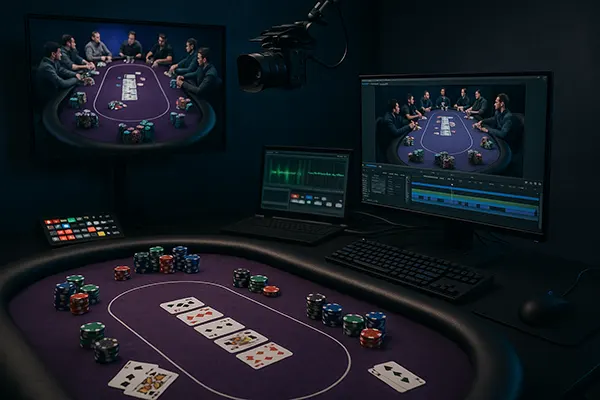How Streaming Poker Studios Operate: Technology, Card Room Security and Anti-Peeking Measures

Streaming poker studios in 2025 combine professional broadcasting standards with advanced security protocols designed to protect card integrity and ensure fair play. Modern studios rely on real-time monitoring, encrypted data channels and controlled physical environments where every card movement is supervised. The industry has shifted towards transparent systems that allow operators to demonstrate compliance with international security requirements while supporting stable and accurate live streams for viewers and tournament officials.
Core Technologies Behind Modern Poker Broadcasts
The technical foundation of a contemporary poker studio involves several layers of hardware and software working in synchronisation. Dedicated cameras record each position at the table, while overhead units capture community cards clearly. These cameras feed into a central production system equipped with low-latency encoders that preserve stream quality without interrupting gameplay.
Another critical component is the card recognition system. Many studios use RFID-embedded cards that interact with sensors placed under the table. These sensors read the card identity instantly and transmit the information to the production desk securely. This removes the risk of human error and gives commentators accurate data that appears on screen in real time.
Maintaining stream stability is equally important. Studios use redundant internet channels, including dedicated fibre lines and 5G-based failover links, to prevent interruptions. Operators monitor bitrate, latency and packet loss throughout the event to ensure that the broadcast remains clean and consistent for audiences around the world.
Real-Time Data Processing in Professional Card Rooms
Real-time data systems convert card readings and camera feeds into a unified interface visible only to authorised production staff. These systems use timestamp synchronisation so that each action, from a player’s bet to dealer movements, aligns precisely with what is shown on screen. This ensures analytical accuracy and supports officiating teams who verify disputes.
To protect sensitive data, studios encrypt all transmissions using high-grade protocols such as TLS 1.3. Access to the data console requires multi-factor authentication, and the system logs every instance of user interaction. This approach prevents unauthorised viewing of player hands and maintains full accountability.
Advanced monitoring dashboards also alert technicians about any irregularities in card readings or stream behaviour. Whether a sensor misfires or a camera loses focus, operators receive immediate notifications and can adapt without disrupting the broadcast or affecting game fairness.
Security Measures Protecting the Card Room
Protecting the integrity of a poker broadcast begins with strict physical control of the studio. Access is authorised through biometric entry systems, and all personnel must follow a documented chain of responsibility. Surveillance cameras record every angle of the room, including storage areas where decks are sealed before use.
Deck preparation is handled under continuous supervision. Cards are unsealed on camera, shuffled through verified machines and then transferred directly to the dealer. This reduces the likelihood of tampering and ensures traceability for every deck used during a session.
Security teams also audit equipment regularly. They inspect RFID sensors, cameras, microphones and shuffling devices to guarantee that nothing has been altered. Regular audits are particularly important for large tournaments, where high stakes demand a fully transparent and well-regulated environment.
Digital Protection Against Unauthorised Access
Digital security plays an equally significant role in maintaining trust in a streamed poker room. Dedicated servers store encrypted game information and analytics, isolating them from general network traffic. This minimises the risk of data leaks or unauthorised interception.
Studios implement layered firewalls, behavioural threat detection and isolated VLANs for critical systems. If suspicious behaviour occurs on any connected device, automated protocols restrict access instantly and alert security specialists. This helps maintain uninterrupted gameplay without compromising accuracy or fairness.
Regular penetration testing ensures that systems remain compliant with international regulations. Independent auditors simulate attack scenarios to verify that the studio’s digital infrastructure is resilient. This level of preparedness strengthens overall trust in the integrity of poker broadcasts.

Anti-Peeking Strategies and Player Protection
Preventing peeking is a key priority for modern poker studios, as live broadcasts increase the need for robust protection. Physical barriers, such as elevated table edges and dealer-controlled card exposure angles, minimise the risk of neighbouring players seeing hidden cards. Designers constantly refine table layouts to support natural gameplay while maintaining strict visibility control.
Many studios rely on specially designed playing surfaces that restrict reflections and unwanted angles. Cards are printed on matte stock to eliminate shine under strong broadcast lighting, reducing accidental reveals to opponents or cameras that are not intended to display player hands.
Additionally, trained staff monitor every movement from an external control room. If a dealer unintentionally reveals a card or a player’s gesture creates a visibility risk, the studio records the incident and can take the appropriate operational steps. This oversight supports a safer and more consistent poker environment for all participants.
Technological Barriers Preventing Information Leaks
To ensure that player hands remain confidential, studios separate the live feed from the information feed containing card data. The broadcast shown to viewers is delayed, typically by 30 to 60 seconds. This prevents anyone from using card information in real time to influence decisions at the table.
Card identity data is accessible only to selected staff and uses limited-scope terminals that cannot connect to external networks. Production operators follow strict protocols that prevent them from communicating with the table area during active hands, reducing any possibility of informational advantage.
Some studios also employ radio-frequency shielding around the table to block unauthorised scanning tools. This prevents external devices from detecting RFID card signals, ensuring that only the studio’s approved equipment can read card information accurately and securely.




